Related Research Articles

Hawaii is a U.S. state located in the Pacific Ocean. It is the only state outside North America, the only island state, and the only state in the tropics. Hawaii is also one of a handful of U.S. states to have once been an independent nation.

USS Long (DD-209/DMS-12), named for John Davis Long (1838–1915), Secretary of the Navy from 1897 to 1902, was a Clemson-class destroyer of the United States Navy.

The Pacific Time Zone (PT) is a time zone encompassing parts of western Canada, the western United States, and western Mexico. Places in this zone observe standard time by subtracting eight hours from Coordinated Universal Time (UTC−08:00). During daylight saving time, a time offset of UTC−07:00 is used.

USS Chandler (DD-206/DMS-9/AG-108) was a Clemson-class destroyer in the United States Navy. She was the only ship named for William Eaton Chandler, who served as Secretary of the Navy from 1882 to 1886.

Laysan, located 808 nautical miles northwest of Honolulu at N25° 42' 14" W171° 44' 04", is one of the Northwestern Hawaiian Islands. It comprises one land mass of 1,016 acres (4.11 km2), about 1 by 1 1⁄2 miles in size. It is an atoll of sorts, although the land completely surrounds a shallow central lake some 8 feet (2.4 m) above sea level that has a salinity approximately three times greater than the ocean. Laysan's Hawaiian name of Kauō means egg.
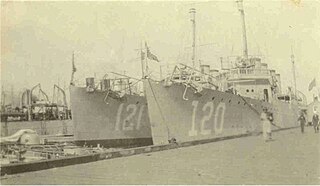
USS Montgomery (DD–121) was a Wickes-class destroyer in the United States Navy during World War I, later reclassified DM-17. She was the fifth ship named Montgomery and was named for Rear Admiral John B. Montgomery.
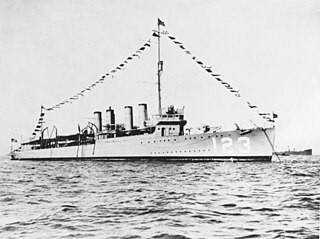
USS Gamble (DD–123/DM-15) was a Wickes-class destroyer in the United States Navy during World War I, later converted to a minelayer in World War II. She was named for two brothers, Lieutenant Peter Gamble and Lieutenant Colonel John M. Gamble.

The fourth USS Preble (DD-345/DM-20/AG-99) was a Clemson-class destroyer in the United States Navy following World War I, and saw combat in World War II as a minelayer. She was named for Commodore Edward Preble.
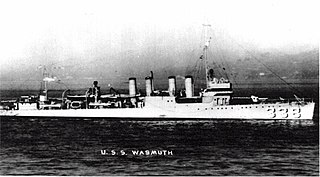
USS Wasmuth (DD-338/DMS-15) was a Clemson-class destroyer in the United States Navy following World War I. She was named for Henry Wasmuth.

SS President Coolidge was an American luxury ocean liner that was completed in 1931. She was operated by Dollar Steamship Lines until 1938, and then by American President Lines until 1941. She served as a troopship from December 1941 until October 1942, when she was sunk by mines in Espiritu Santo in the New Hebrides, part of current-day Vanuatu. President Coolidge had a sister ship, SS President Hoover, completed in 1930 and lost when she ran aground in a typhoon in 1937.

The second USS Ardent (AM-340) was a Auk-class minesweeper in the United States Navy.
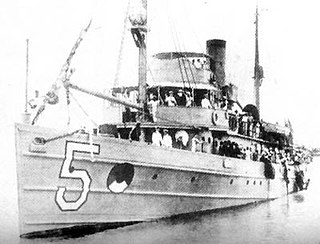
USS Tanager (AM-5) was an Lapwing-class minesweeper acquired by the U.S. Navy for the dangerous task of removing mines from minefields laid in the water to prevent ships from passing.
USS Brant was a YMS-1-class minesweeper built for the United States Navy during World War II.
USS Spectacle (AM-305) was a steel-hulled Admirable class minesweeper built for the U.S. Navy during World War II. A trained crew boarded the new vessel, practiced with her minesweeping gear, and then proceeded to the Pacific Ocean to clear mines from Japanese beaches so that Allied forces could invade. While performing this dangerous task of mine clearance, a Japanese plane strafed her, and another deliberately crashed into her. When she returned to the United States, her battle damage was so severe that the U.S. Navy decided to scrap, rather than to repair, her. She was awarded two battle stars.

Hula Girls is a Japanese film, directed by Sang-il Lee and co-written by Lee and Daisuke Habara, and first released across Japanese theaters on September 23, 2006. Starring Yū Aoi, Yasuko Matsuyuki, Etsushi Toyokawa, Shizuyo Yamazaki, Ittoku Kishibe, Eri Tokunaga, Yoko Ikezu and Sumiko Fuji, it is based on the real-life event of how a group of enthusiastic girls take on hula dancing to save their small mining village, Iwaki, helping the formation of Joban Hawaiian Center, which was later to become one of Japan's most popular theme parks. It received its premiere at the Toronto International Film Festival.
USS Prestige (AMc-97) was an Accentor-class coastal minesweeper acquired by the U.S. Navy for the dangerous task of removing mines from minefields laid in the water to prevent ships from passing.
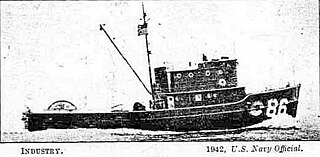
USS Industry (AMc-86) was an Accentor-class coastal minesweeper acquired by the U.S. Navy for the dangerous task of removing mines from minefields laid in the water to prevent ships from passing.

USS Siskin (AMS-58/YMS-425) was a YMS-1-class minesweeper of the YMS-135 subclass built for the United States Navy during World War II. She is the only U.S. Navy ship to be named for the siskin.

USS Inflict (AM-456/MSO-456) was an Aggressive-class minesweeper acquired by the U.S. Navy for the task of removing mines that had been placed in the water to prevent the safe passage of ships.

Philodoria is a genus of moths in the family Gracillariidae. All species are endemic to Hawaii. It was first described by Lord Walsingham in 1907.
References
- ↑ Zimmerman, Elwood C. (1978). Insects of Hawaii. 9 Microlepidoptera. The University Press of Hawaii, Honolulu. hdl:10125/7338.
| This article relating to moths in subfamily Gracillariinae is a stub. You can help Wikipedia by expanding it. |